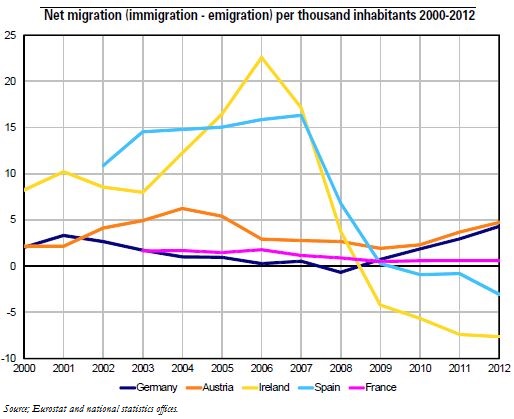Trésor-Economics No. 143 - Labour mobility in the EU: dynamics and policies
Labour mobility contributes to the smooth functioning of the internal market in the European Union by ensuring a better match between labour supply and demand, which is necessary to reduce unemployment and increase productivity. Furthermore, in a monetary union such as the euro area, labour mobility could act as an automatic stabiliser against asymmetric shocks, since monetary policy responds primarily to shocks affecting the euro area as a whole and some countries' fiscal policies may be severely constrained.
Labour mobility between countries within the European Union, and within the euro area, is relatively low, especially compared to mobility between States in the United States. Nevertheless, the enlargement of the EU over the previous decade led to substantial migration from new Member States of Eastern Europe to Member States in the west. Furthermore, since the crisis, there have been significant migration flows, as unemployment rose in the hardest hit countries and unemployment rates diverged widely within the euro area.
The Member States that have been hit hardest by the crisis since 2008 have seen a reversal in migration flows. Migrants returning to their native countries in Eastern Europe and Latin America or migrants moving on to another EU country, such as the United Kingdom, account for much of these migratory flows. However, the movement of euro-area citizens within the single currency area has also increased significantly.
Germany has seen a large increase in the number of immigrants since 2008. If most of the migrants come from Eastern Europe, there has also been an increase in immigrants from peripheral countries of the euro area. However, these flows are still very small compared to the expected decrease in the size of the German labour force as the country's population ages.
Greater mobility of European workers may be supported by actions to reduce cultural and linguistic barriers (through exchange programmes, etc) and to reduce administrative obstacles (portability of rights, etc.) However, if high unemployment in the countries hardest hit by the crisis was to persist, preventing them from catching up to the rest of Europe, new waves of mobility could appear, with permanent one-way flows of migrants from the peripheral countries to the "core". In such a hypothetical situation, European investment programmes and social mechanisms would be required to offset the impact of potential agglomeration effects.
